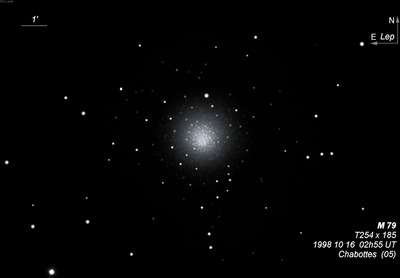
Pierre Méchain discovered M79 = NGC 1904 on 26 Oct 1780. He reported it to Messier, who confirmed its position, and included it in his 1780 catalogue. Wolfgang Steinicke reports that William Herschel first observed the cluster on 4 Mar 1783 (before his sweeps) with his 6.2-inch reflector. On 17 Nov 1784, WH recorded M79 as "a fine cluster of stars, near 3' dia. Extremely compressed but completely resolved." On 13 Jan 1806, he observed with his "Large 10 feet" and logged "The 79th of the Connoiss. is a cluster of stars of a globular construction, and certainly extremely rich. Towards the centre the stars are extremely compressed, and even a good way from it. With 171 the diameter is a little less than 1/3 of the field, and with 220 a little more; the field of one being 9'0", and of the other 8'0", a mean of both gives the diameter of the cluster 2'50", but I suppose that the lowness of the situation prevents my seeing the tiny scattered stars, so that this cluster is probably larger than it appears."
200/250mm - 8" (9/25/81): small bright core, a few stars are resolved at the edge of the mottled core. The outer halo is well resolved in excellent conditions.
300/350mm - 13" (1/19/85): at 360x, about 40 stars resolved in good seeing including a few over the core.
400/500mm - 17.5" (1/9/99): at 280x, M79 is well resolved into several dozen stars. Contains a sharply concentrated intense core, ~2' in diameter which is clumpy, mottled and partially resolved at its periphery. The inner part of the halo is peppered with faint stars. The background haze drops off significantly towards the outer portion of the halo but a number of brighter stars are resolved including a nice arc of stars along the following edge of the halo. A evenly matched close pair is on the northeast side and a mag 12 star (a post-AGB star that belongs to the cluster) is at the north edge. Located 35' NE of naked-eye 5th magnitude h3752 (5.5/6.7 at 3").
17.5" (12/8/90): 40-50 stars resolved mostly in the halo or at the edge of the very mottled core. A string of six stars is just east of center and a long string passes through the core. The brightest mag 12.5 star is north of the core.
17.5" (12/3/88): three dozen stars resolved, mostly at the edges of the core and in the halo.
17.5" (12/19/87): at 220x, three dozen stars were resolved.
Notes by Steve Gottlieb